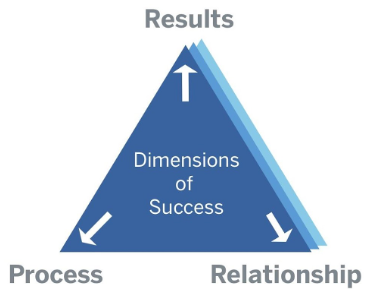Living and Working Virtually in Uncertainty: Balancing the Dimensions of Success
March 24, 2020 Leave a commentFacilitative Leaders balance three essential dimensions of success: results, process, and relationship. That means not just paying attention to getting the job done successfully, but paying attention to the relationships among people along the way, and to the processes and use of resources to get it done. Most leaders tend to emphasize one of these dimensions more than the others. That it makes it important to create teams with people who are inclined to focus on different dimensions. That way the effort is more likely to experience three-dimensional success.

© Interaction Institute for Social Change
Typically, when in doubt or under stress, I default to process. I’m asking questions like: Are we including all the right people? Do we have the resources we need in place? Can we get it done on the timeline we envision? Sometimes, like recently at IISC, I’ve been defaulting to results. On a recent Monday, we began thinking through how to create some short webinars focused on bringing love, equity, and network practices to virtual meetings. The question was how to offer something that was uniquely IISC, that could be useful in this time of uncertainty and virtual working, and that wouldn’t require more than we had to invest in the effort.
I was focused on the results. We have a lot of content and enough know-how to create something that could be really useful that could be complementary to the resources we’ve seen others share recently. As for process, I thought we could put together a viable product with minimal effort, and I wanted to engage the relevant stakeholders within IISC early. As expected, bringing in a broader set of players kept making the ideas better. As for relationship, I was focused on doing this in ways that honored our different kinds of expertise. I was hoping this would also build our team spirit through an “all hands on deck” experience that didn’t create much stress.
But I was wrong … As the week progressed, it seemed that around every corner there was a new technical impediment that made the effort seem less and less simple. And, team members were feeling more and more burdened by this new effort on top of various personal and workplace challenges. So, in order not to get way out of balance in our efforts to help others get in balance, we are rethinking the project. In the meanwhile, here are a few ideas about how you can attend to results, process, and relationship as you design and facilitate your virtual meetings.
Results
- Establish clear desired outcomes. What are we trying to accomplish in this meeting?
- Make sure the outcomes are can be accomplished in the time allotted. If your team is new to virtual meetings, you may need to make the outcomes even more bite-sized than usual.
- Make sure the outcomes are relevant and meaningful to the participants, particularly in light of everything else they have on their minds.
Process
- Remember your best in-the-room meeting processes
- Make sure you have a clear agenda. Ask for input and feedback on the agenda before the meeting.
- Assign or ask for volunteers to facilitate, keep time, and take notes.
- Especially for virtual meetings
- Assign virtual meeting roles (e.g., people to check the chat, help with technical problems, check the energy in the virtual room, etc.).
- Create multiple opportunities for engagement within each agenda item (e.g., spoken comments, chat, white board, writing in a shared document).
- Use visuals (e.g., slides, shared documents).
- Call on people, mix up the speaking order with each conversation.
- Ask a question and have each person “toss” to another person until everyone has answered.
- If you don’t have access to video conferencing, use real-time shared documents (like Google Docs) to create notes that everyone can see and contribute to while the call is in progress.
- Keep audio-only participants in the loop, by updating them on anything you’re sharing visually and remembering to invite them into the conversation.
Relationships
- Begin and end with time to connect personally, through full-group check-ins and check outs.
- Use breakout rooms to increase opportunities to connect.
- If you (or some of your participants) don’t have access to video conferencing, create a visual team roster in your shared document so everyone can see a photo of everyone on the call.
- While it may not always be appropriate to have other household members “pop in” to your meetings, we make a point of acknowledging and welcoming children, partners, other household members, and pets when they pop into the room. Especially in these times, far from being unwelcomed distractions, we view these moments as precious opportunities to really see our colleagues.
All the best as you balance the dimensions of success in these trying times. And stay tuned. More resources are coming – whether they are webinars or something else remains to be seen. 🙂

